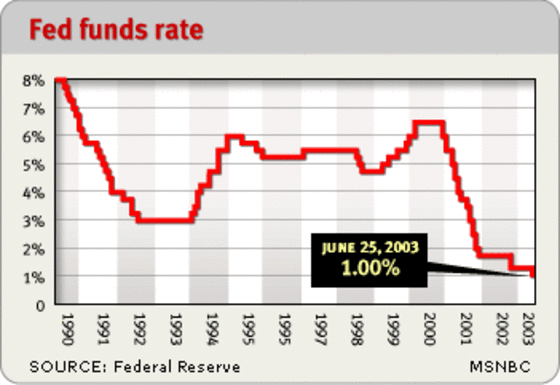Federal Reserve Chairman Alan Greenspan and fellow policy-makers left short-term interest rates unchanged at their lowest levels in 45 years Tuesday, expressing only guarded optimism that the sluggish economy is showing signs of recovery. The central bank also said it intends to leave rates low for a “considerable period,” mainly to prevent inflation from falling to dangerously low levels.
The Fed's decision had been widely expected after the central bank cut the benchmark overnight rate to 1 percent in June in its latest bid to revive the ailing economy and head off the possibility of deflation, or widespread falling prices. In a statement issued after Greenspan and other Fed officials concluded their latest meeting, the central bank emphasized that declining inflation remains its biggest concern and gave the clearest signal yet that it has no plans to raise short-term rates in the foreseeable future.
The Fed’s muted statement was seen as an effort by the central bank to soothe the bond market, which has been roiled in recent months by conflicting signals about the possibility of deflation and the Fed’s plan to attack it.
“This was a much clearer statement than the one we saw on June 25 and probably an attempt to calm nerves in the bond market,” said David Rosenberg, chief North American economist for Merrill Lynch. “The Fed was very clear that the predominant concern is over disinflation.”
The bond market was sent reeling after the Fed’s last meeting concluded June 25 when the central bank cut short-term interest rates by only a quarter-percentage point rather than the half-point many traders had expected. Long-term market interest rates, including mortgage rates, quickly shot up by more than a percentage point from levels that had not been seen since the 1950s.
Long-term rates were little changed on the bond market after the Fed announcement Tuesday, while stock prices were moderately higher.
Rosenberg said he found it noteworthy that the Fed was unable to point to much evidence of the economic upturn that most economists expect. The central bank said spending is “firming” but labor market indicators have been “mixed.” The comments were somewhat less upbeat than the Fed’s June 25 statement, which saw “markedly improved financial conditions” and signs that the labor market was “stabilizing.”
Since then there have been two more gloomy monthly reports on employment, showing that the economy has lost jobs for six straight months despite a putative economic expansion that began in November 2001 after an eight-month recession.
“From the Fed’s perspective the labor market gets a lot of weight in their thinking,” said Ethan Harris, chief U.S. economist at Lehman Bros.
“It’s way too early to tell how strong the recovery is going to be,” he said. “All we know is that some kind of pickup is under way.”
Rosenberg, who expects the Fed to stay on hold until at least 2005, pointed out that after the 1991-92 recession the Fed did not raise rates until the economy had added more than 4 million jobs.
So far the economy has lost some 2.5 million jobs since January 2001, when the Fed initiated the first of 13 rate cuts that have brought the benchmark federal funds rate down from 6 percent. The lower rates have made it cheaper for consumers and businesses to borrow, affecting everything from credit cards to business credit lines to mortgage rates.
To be sure, there have been faint signs of economic improvement in recent weeks, including rising business confidence, improving factory orders and a decline in new claims for jobless benefits. And most economists, including Fed policy-makers, believe the economy is almost certain to pick up speed substantially in the second half of the year, boosted by a $350 billion federal tax cut as well as the historically low interest rates and a rising stock market.
“I think what the Fed is waiting for obviously is the labor market to turn around, said Mario De Rose, fixed income strategist at Edward Jones Investments in St. Louis. “That is the final piece of the puzzle.”
Complete text of Fed statement
The Federal Open Market Committee decided today to keep its target for the federal funds rate at 1 percent.
The Committee continues to believe that an accommodative stance of monetary policy, coupled with still-robust underlying growth in productivity, is providing important ongoing support to economic activity. The evidence accumulated over the intermeeting period shows that spending is firming, although labor market indicators are mixed. Business pricing power and increases in core consumer prices remain muted.
The Committee perceives that the upside and downside risks to the attainment of sustainable growth for the next few quarters are roughly equal. In contrast, the probability, though minor, of an unwelcome fall in inflation exceeds that of a rise in inflation from its already low level. The Committee judges that, on balance, the risk of inflation becoming undesirably low is likely to be the predominant concern for the foreseeable future. In these circumstances, the Committee believes that policy accommodation can be maintained for a considerable period.
Voting for the FOMC monetary policy action were: Alan Greenspan, Chairman; Ben S. Bernanke; Susan S. Bies; J. Alfred Broaddus, Jr.; Roger W. Ferguson, Jr.; Edward M. Gramlich; Jack Guynn; Donald L. Kohn; Michael H. Moskow; Mark W. Olson; Robert T. Parry; and Jamie B. Stewart, Jr.
